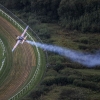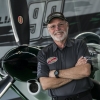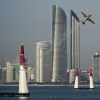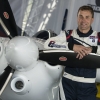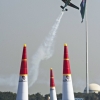SALZBURG (Austria) For the casual observer the 2014 Red Bull Air Race World Championship might look pretty much like the same thrilling high-speed, low-altitude flying competition that they saw in 2010.
But anyone who looks beneath the surface will discover a number of virtually indistinguishable features that have been introduced to make the world’s fastest motorsport series even safer when it returns with eight races for the 2014 World Championship that starts off with the season opener in Abu Dhabi on February 28/March 1.
The lightweight nylon material pylons are made of is one of a number of important changes – its technology has been advanced through 30 rounds of improvements to make it even easier to rip apart if the pylon is touched by a plane’s wings. Also, the height of the pylons that mark the racetrack and form the Air Gates has been raised from 20 meters to 25 meters, ostensibly a small increase in altitude but an important improvement. Another change is that the high-G 270-degree “Quadro” turn through a set of four pylons set up in a tight square used in the past has been eliminated due to the exceedingly high g-force it exerted on the plane and pilot.
Additionally the modus and rules have been tightened to help prevent any pilots from exceeding the set limits. The pilots have certainly noticed the changes in their training but even experienced observers watching a Red Bull Air Race training camp in 2013 could not really even notice that the pylons were 5 meters higher or the “Quadro” had been eliminated. It was still just as thrilling to see, hear and feel the planes in their high-speed routine.
“We’ve all worked very hard over the last three years fine-tuning some of the safety aspects and bringing the sport to a new level,” says Erich Wolf, the CEO of Red Bull Air Race GmbH.
The biggest change for the pilots is the usage of standardized engines and propellers – which will put an even higher focus on pilot performance and aerodynamics. “This will be interesting. It will level the playing field in power but it’ll also expose any aerodynamic strengths or weaknesses as well as differences in aircraft weight,” says reigning World Champion Paul Bonhomme.
In their quest to improve, pilots were engaged in a costly high-tech battle in 2010 to tune their engines. That won’t happen in 2014 when all pilots will have the same race-tuned Lycoming Thunderbolt 300hp engines.
The pilots who made the Red Bull Air Race World Championship an international success in 2010 return and will doubtlessly make the 2014 title battle more thrilling than ever.

